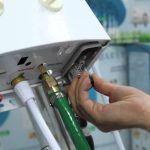When it comes to sewer repair, there are two primary methods: traditional and trenchless. Each approach has its own advantages and disadvantages, impacting the repair process’s efficiency, cost, and environmental impact.
In this article, we’ll talk about the key differences between trenchless and traditional sewer repair, shedding light on which method might best fit your specific needs.

Content
Trenchless Sewer Repair: Minimal Disruption, Maximum Efficiency
Trenchless sewer repair eliminates the need for extensive digging. Instead, it employs innovative technologies like pipe bursting and pipe lining, making it a non-invasive solution. This minimizes disruption to landscapes and structures and results in quicker repair times.
Traditional Sewer Repair: The Digging Dilemma
In contrast, traditional sewer repair involves extensive excavation to access the damaged pipes. This can cause disturbances to roads, sidewalks, and landscaping, leading to additional costs for restoring these elements after the repair is complete.
Environmental Impact
Trenchless sewer repair stands out for its eco-friendliness. The reduced digging means less soil disturbance and lower carbon emissions associated with equipment. It’s an environmentally conscious choice that aligns with modern sustainability goals.
Cost Considerations
Though trenchless sewer repair may seem costlier initially, it often proves more budget-friendly in the long run. With reduced labor and restoration expenses, the overall project cost is usually lower than traditional methods, which require more extensive work.
Durability and Longevity, Trenchless Wins
Trenchless repairs ensure the creation of seamless, jointless pipes, minimizing the risk of future leaks and root intrusion. This results in a longer-lasting solution compared to traditional repairs, which may be more prone to reoccurring issues.
Speedy Completion – Trenchless for Time-Sensitivity
If you’re facing a time-sensitive sewer problem, trenchless repair is the way to go. Its streamlined process significantly reduces repair time, making it an ideal choice for busy urban areas or commercial properties where quick solutions are essential.
Suitability for Various Pipe Materials
Trenchless methods can accommodate a wide range of pipe materials, including clay, PVC, and cast iron. This versatility makes it suitable for different pipe types, providing an all-encompassing solution.
Challenging Terrain
In areas with challenging terrain or hard-to-reach locations, trenchless sewer repair excels. Its ability to navigate obstacles underground without excessive excavation makes it a practical choice for tricky repair scenarios.
Conclusion
When deciding between trenchless and traditional sewer repair methods, carefully weigh the pros and cons. Trenchless technology emerges as the efficient, eco-friendly, and cost-effective, ensuring minimal disruption and long-term reliability. Consider your specific repair needs and consult with professionals to make an informed choice that best suits your sewer repair requirements.

My name is Author Name. I post about home improvement ideas and how to make your home look beautiful and liveable. I hope my posts will help you with your DIY projects!











